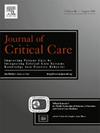Effectiveness of prophylactic push-dose vasopressors for preventing arterial hypotension during elective orotracheal intubation: A systematic review and meta-analysis
IF 2.9
3区 医学
Q2 CRITICAL CARE MEDICINE
引用次数: 0
Abstract
Background
Orotracheal intubation is frequently associated with arterial hypotension, particularly during induction with agents such as propofol. The use of prophylactic push-dose vasopressors (Push-Dose Pressor - PDP) has been proposed to mitigate this drop in blood pressure. However, the effectiveness of PDPs remains uncertain.
Methods
We conducted a systematic review and meta-analysis of randomized controlled trials (RCTs) assessing the use of PDPs (epinephrine, ephedrine, phenylephrine, or metaraminol) during sedation for tracheal intubation in adult normotensive patients. Searches were performed in MEDLINE, Embase, and Cochrane Library from inception to September 2024. The primary outcome was the difference in mean arterial pressure (MAP) and systolic blood pressure (SBP) before and after intubation between patients who received PDPs and those who did not. Data were synthesized using an inverse variance method, with heterogeneity assessed using Cochran's Q and I2.
Results
Twenty-four RCTs involving 1915 patients were included. Most trials were conducted in operating rooms among ASA I–II patients undergoing elective procedures. PDP administration resulted in higher MAP (mean difference: 7.6 mmHg; 95 % CI: 4.3–10.8; I2 = 82 %) and SBP (mean difference: 12.5 mmHg; 95 % CI: 6.4–18.5; I2 = 92 %) compared with controls. Sensitivity analyses excluding phenylephrine or stratifying ephedrine doses yielded consistent findings. Overall certainty of evidence was low due to heterogeneity and indirectness.
Conclusions
Prophylactic push-dose vasopressors modestly increase arterial pressure during tracheal intubation in elective surgical patients. Given the low certainty of evidence and limited generalizability, routine use cannot be currently recommended.
选择性气管插管期间预防性推剂量血管加压药物预防动脉低血压的有效性:一项系统回顾和荟萃分析。
背景:经气管插管经常与动脉低血压相关,特别是在异丙酚等药物诱导时。已建议使用预防性推剂量血管加压药(push-dose Pressor - PDP)来缓解这种血压下降。然而,pdp的有效性仍不确定。方法:我们对随机对照试验(RCTs)进行了系统回顾和荟萃分析,评估pdp(肾上腺素、麻黄碱、苯肾上腺素或甲氨酚)在成人正常血压患者气管插管镇静期间的使用情况。检索在MEDLINE, Embase和Cochrane Library中进行,从成立到2024年9月。主要结局是接受pdp和未接受pdp的患者插管前后的平均动脉压(MAP)和收缩压(SBP)的差异。采用反方差法综合数据,采用Cochran’s Q和I2评估异质性。结果:纳入24项随机对照试验,涉及1915例患者。大多数试验是在接受选择性手术的ASA I-II患者的手术室中进行的。与对照组相比,PDP治疗导致MAP(平均差值:7.6 mmHg; 95% CI: 4.3-10.8; I2 = 82%)和收缩压(平均差值:12.5 mmHg; 95% CI: 6.4-18.5; I2 = 92%)升高。敏感性分析排除了苯肾上腺素或分层麻黄素剂量,结果一致。由于异质性和间接性,证据的总体确定性较低。结论:选择性手术患者气管插管时预防性推剂量血管加压药物可适度增加动脉压。鉴于证据的低确定性和有限的普遍性,目前不建议常规使用。
本文章由计算机程序翻译,如有差异,请以英文原文为准。
求助全文
约1分钟内获得全文
求助全文
来源期刊

Journal of critical care
医学-危重病医学
CiteScore
8.60
自引率
2.70%
发文量
237
审稿时长
23 days
期刊介绍:
The Journal of Critical Care, the official publication of the World Federation of Societies of Intensive and Critical Care Medicine (WFSICCM), is a leading international, peer-reviewed journal providing original research, review articles, tutorials, and invited articles for physicians and allied health professionals involved in treating the critically ill. The Journal aims to improve patient care by furthering understanding of health systems research and its integration into clinical practice.
The Journal will include articles which discuss:
All aspects of health services research in critical care
System based practice in anesthesiology, perioperative and critical care medicine
The interface between anesthesiology, critical care medicine and pain
Integrating intraoperative management in preparation for postoperative critical care management and recovery
Optimizing patient management, i.e., exploring the interface between evidence-based principles or clinical insight into management and care of complex patients
The team approach in the OR and ICU
System-based research
Medical ethics
Technology in medicine
Seminars discussing current, state of the art, and sometimes controversial topics in anesthesiology, critical care medicine, and professional education
Residency Education.
 求助内容:
求助内容: 应助结果提醒方式:
应助结果提醒方式:


